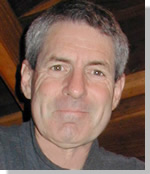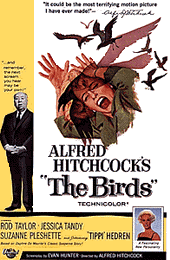 On The Road
On The Road
by: Bill Oetinger 10/1/2000
Back Roads and Back Lots
|
|
This being October, I had thought to write one of my obligatory autumn columns, celebrating the changing of the seasons. But as I considered the usual elements to include in such an essay--the colors of the leaves and the quality of the light--I was sidetracked by another notion: that the great variety of our Northern California landscape is forever showing up in films, on television, and in print, and that those appearances are often packaged to appear to be somewhere other than where they really are.
What got me started on this line of thinking is a ride our club schedules every fall that makes a loop through central Marin County, our neighbor to the south. Part of this ride is up on Mount Tamalpais and part of it meanders through the chain of villages that hugs the base of the mountain: Mill Valley, Ross, San Anselmo, Fairfax. While the marquee attraction on this ride is always supposed to be the journey up the mountain, an added dividend is that some of these little towns put on impressive displays of autumn color along their neighborhood lanes. That's why we always do this ride in October or early November.
The town of Ross is especially blessed in this respect, with several avenues of stately old broadleaf trees that could be the pride of any New England village. I lived in Ross in the early 70s, just a block off Lagunitas Road, one of the best of these tree-lined lanes. One morning when I went out for a ride, I found my street bustling with all the activity that surrounds the making of a movie. This was in fact Francis Ford Coppola filming a portion of The Godfather. It's the scene where Al Pacino drives up from New York to visit Diane Keaton in the small town where she lives (theoretically somewhere in New Hampshire, if I remember correctly). It's autumn in the story line, and as the couple strolls along the side of the road, the scene is bathed in the golden glow of turning leaves, drifting down from those grand old trees. Most folks who see the movie would be surprised to know that this classic tableau of New England color was actually filmed 30 miles north of San Francisco.
Another of my favorite moments of landscape masquerade occurs in a Rolling Rock Beer commercial. Rolling Rock is--I believe--produced in Pennslyvania. This ad plays on the pristine, rural roots of the beer by following a Rolling Rock delivery truck along a country road, supposedly transporting fresh product from the brewery to the city. The only problem is that this vision of bucolic Pennsylvania byways was actually shot near the junction of Franklin School Road and Whittaker Bluff Road, just south of the Marin-Sonoma line. The sport where they set their camera is one of my all-time favorite spots to stop on a bike ride and admire the view, and I seldom ride through here without imagining that beer truck trundling over the Estero San Antonio bridge below Whittaker Bluff...a long way from Pennsylvania.
Then there is Mendocino, that darling of the entertainment industry. Like an old character actor forever type-cast in the same role, the town seems doomed to be misrepresented again and again on screen as the quintessential, quaint New England village...as Cabot Cove, Maine in Murder She Wrote and as other unnamed, salty seacoast hamlets in countless films, from The Russians are Coming! to Summer of '42 to East of Eden. At least in Steinbeck's East of Eden, the town wasn't pretending to be in New England. In that film, it was a stand-in for--of all places--Salinas! Mendocino isn't the only local burg to be chosen for stardom because of its small-town charm. One of Ronald Reagan's election ads used old-town Petaluma as the backdrop for a bit of cornball Americana. Ironic that the same wholesome streets that worked for Reagan's family values ad were also used to film the most recent version of Lolita.
Not all directors attempt to pass our region off as somewhere else. Alfred Hitchcock let Santa Rosa be Santa Rosa in Shadow of a Doubt. (And wouldn't it be nice if the trains still stopped at Railroad Square, as they did in this 1943 movie?) And of course, his classic  The Birds put Bodega Bay on the map. I recently watched this all the way through, and was impressed at how many scenes in the movie are still recognizable as contemporary Sonoma coast locales. Even though Hitchcock placed the film firmly in Sonoma County, he still was guilty of a little geographical sleight of hand, blending the towns of Bodega and Bodega Bay into one, contiguous entity. In the movie, the school children run downhill from the schoolhouse in Bodega to Lucas Wharf in Bodega Bay...apparently a matter of a few hundred yards. If they really had to run from one town to the other--a distance of over six miles--they'd have all been picked clean by the pursuing birds long before reaching their destination. While much of Bodega Bay has changed in the 40 years since the film was made, you can still ride past the schoolhouse in Bodega, looking much as it did when the crows began gathering on the jungle gym in 1963.
The Birds put Bodega Bay on the map. I recently watched this all the way through, and was impressed at how many scenes in the movie are still recognizable as contemporary Sonoma coast locales. Even though Hitchcock placed the film firmly in Sonoma County, he still was guilty of a little geographical sleight of hand, blending the towns of Bodega and Bodega Bay into one, contiguous entity. In the movie, the school children run downhill from the schoolhouse in Bodega to Lucas Wharf in Bodega Bay...apparently a matter of a few hundred yards. If they really had to run from one town to the other--a distance of over six miles--they'd have all been picked clean by the pursuing birds long before reaching their destination. While much of Bodega Bay has changed in the 40 years since the film was made, you can still ride past the schoolhouse in Bodega, looking much as it did when the crows began gathering on the jungle gym in 1963.
As the Rolling Rock commercial shows, it isn't only famous films that employ our backroads as backdrops. The other half of that Mount Tam ride--the high country above "Ross, New Hampshire"--is highlighted by the run along West Ridgecrest Road, arguably the most filmed and photographed road in California. It is especially popular for car commercials. Sometimes it seems as if you can't turn on the TV without seeing a new car zipping around those gorgeous curves and contours overlooking the Pacific. Over the course of many years--while watching far too much television--I have seen commercials showing literally dozens of our backroads, from Annapolis to Sebastopol to Valley Ford. Sometimes, we don't just see these ads on TV. Sometimes, while out riding, we run into them in process, as they are being produced. Once, we had struggled up the backside of the Geysers, suffering up the steep climb in anticipation of the glorious payback: the long, fast downhill into Alexander Valley on the other side of the mountain. But when we reached the summit, ready to descend like madmen, we were dismayed to find the downhill run soaking wet! What the...? Turns out a water truck had just wetted down the entire road for the filming of a Buick commercial. Apparently the wet road looks better on film. So much for the fast downhill!
I could go on, but that's enough examples for now. These are just a few of the numerous instances where the great visual diversity of our region is exploited by film crews as if this were some vast studio back lot: a little bit of everything, with something for every occasion, and all of it beautiful. And the great scenic diversity that makes it so appealing to film crews makes it a delight for two-wheeled exploration as well. If you ever become even a little bit blasé about the wealth of visual treasures surrounding you as you pedal along our many little lanes, accept a testimonial from all those professional film makers and photographers, who know a good thing when they see it. Their well-trained eyes tell them this area looks superb, whether they're passing it off as somewhere else or simply allowing it to be its own natural self.
Bill can be reached at srccride@sonic.net


